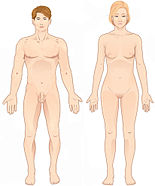
Flexor muscles

Anatomical terminology is a form of scientific terminology used by anatomists, zoologists, and health professionals such as doctors.Older set of terminology shown in Parts of the Human Body: Posterior and Anterior View from the 1933 edition of Sir Henry Morris' Human Anatomy. See also List of human anatomical regions § Deprecated or older regions.Labels of human body features displayed on images of actual human bodies, from which body hair and male facial hair has been removed. Anatomical terminology is a form of scientific terminology used by anatomists, zoologists, and health professionals such as doctors. Anatomical terminology uses many unique terms, suffixes, and prefixes deriving from Ancient Greek and Latin. These terms can be confusing to those unfamiliar with them, but can be more precise, reducing ambiguity and errors. Also, since these anatomical terms are not used in everyday conversation, their meanings are less likely to change, and less likely to be misinterpreted. To illustrate how inexact day-to-day language can be: a scar 'above the wrist' could be located on the forearm two or three inches away from the hand or at the base of the hand; and could be on the palm-side or back-side of the arm. By using precise anatomical terminology such ambiguity is eliminated. An international standard for anatomical terminology, Terminologia Anatomica has been created. Anatomical terminology has quite regular morphology, the same prefixes and suffixes are used to add meanings to different roots. The root of a term often refers to an organ or tissue. For example, the Latin names of structures such as musculus biceps brachii can be split up and refer to, musculus for muscle, biceps for 'two-headed', brachii as in the brachial region of the arm. The first word describes what is being spoken about, the second describes it, and the third points to location. When describing the position of anatomical structures, structures may be described according to the anatomical landmark they are near. These landmarks may include structures, such as the umbilicus or sternum, or anatomical lines, such as the midclavicular line from the centre of the clavicle. The cephalon or cephalic region refers to the head. This area is further differentiated into the cranium (skull), facies (face), frons (forehead), oculus (eye area), auris (ear), bucca (cheek), nasus (nose), oris (mouth), and mentum (chin). The neck area is called the cervix or cervical region. Examples of structures named according to this include the frontalis muscle, submental lymph nodes, buccal membrane and orbicularis oculi muscle. Sometimes, unique terminology is used to reduce confusion in different parts of the body. For example, different terms are used when it comes to the skull in compliance with its embryonic origin and its tilted position compared to in other animals. Here, Rostral refers to proximity to the front of the nose, and is particularly used when describing the skull.:4 Similarly, different terminology is often used in the arms, in part to reduce ambiguity as to what the 'front', 'back', 'inner' and 'outer' surfaces are. For this reason, the terms below are used:
